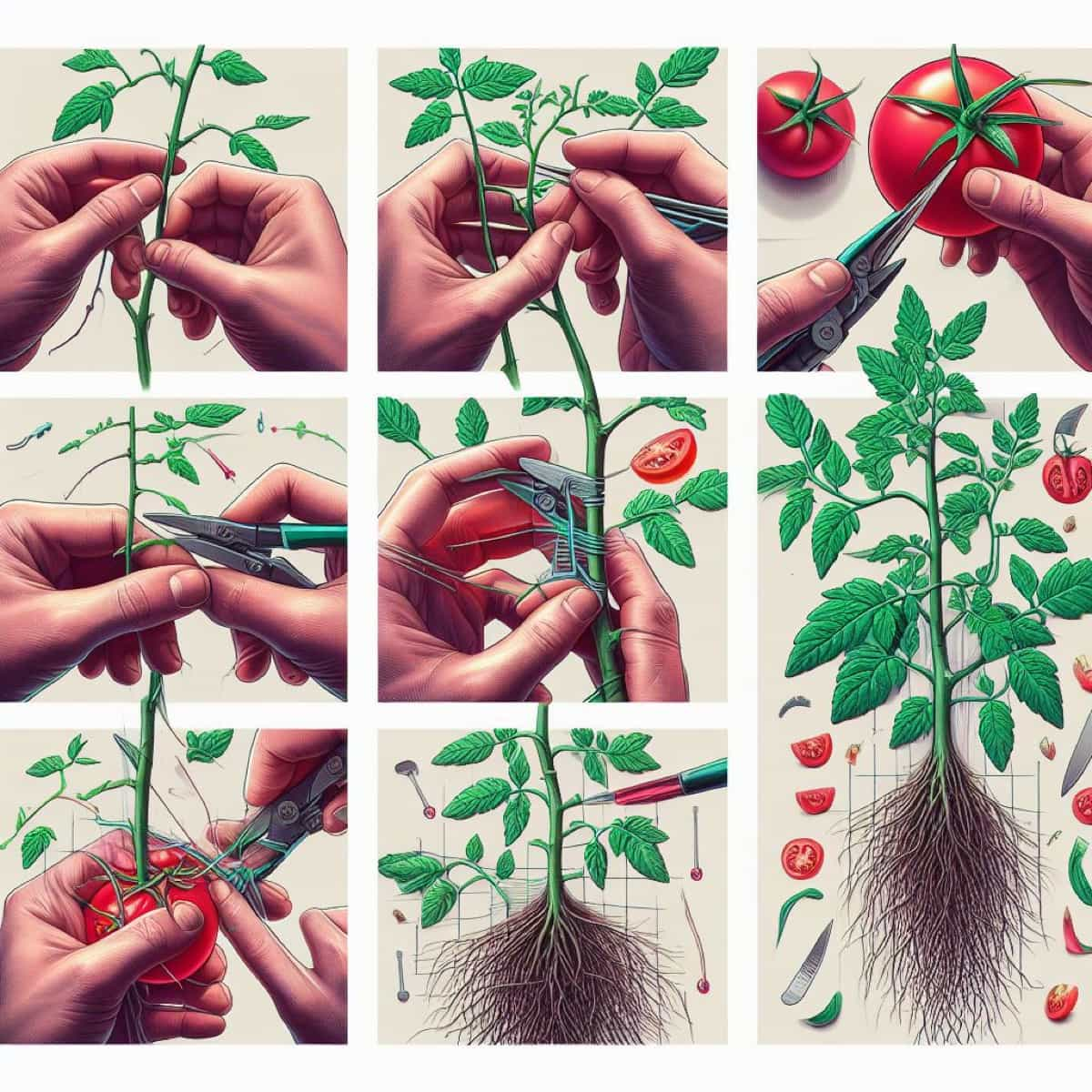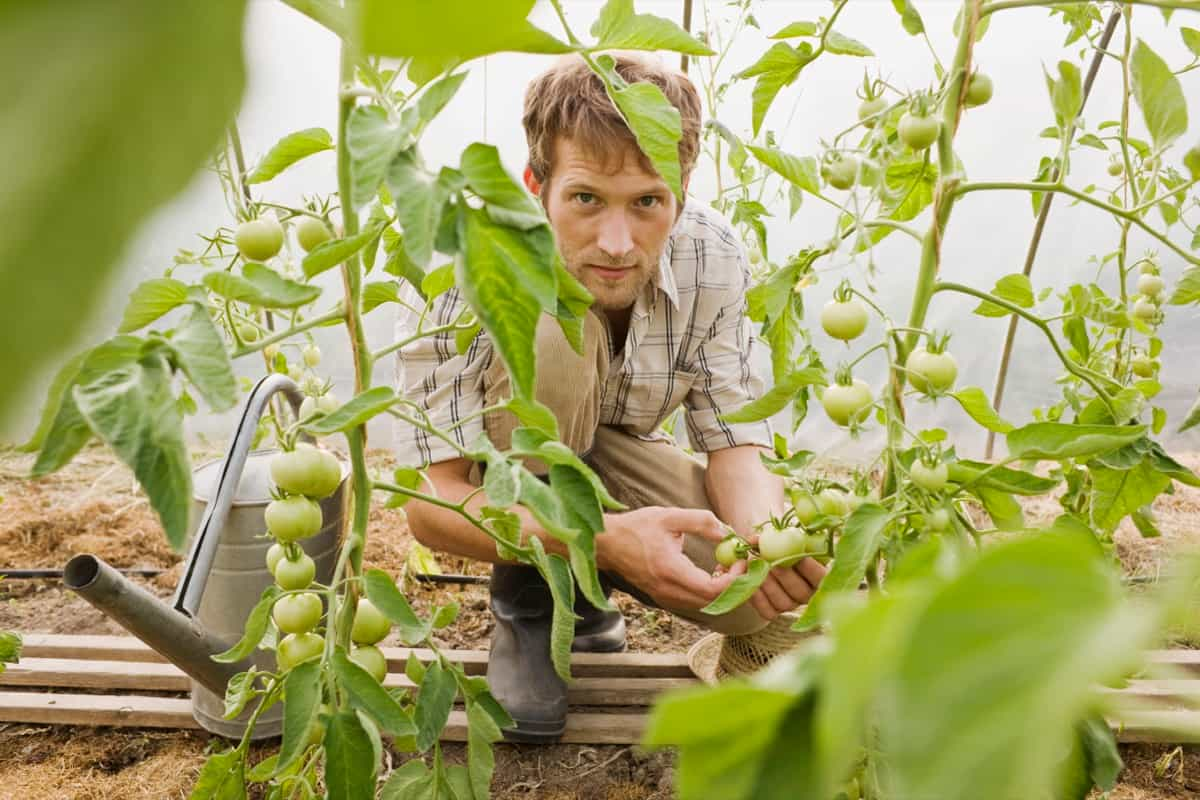Presenting Successful Tomato Grafting Techniques Learn about the numerous benefits, methods, and tomato types to consider when engaging in this exercise. Grafting increases plant vigor, yields more, and improves disease resistance. Thanks to this guide’s simplification, all gardeners may now easily complete the process.

Strategies for Tomato Grafting
What is Tomato Grafting?
A horticultural method called tomato grafting is joining the top part, or scion, of one tomato plant to the rootstock, or root system, of another. By combining the advantageous characteristics of the two plants, this technique improves fruit quality, yield, and disease resistance.
Growers can raise tomatoes in locations with soil-borne diseases or stressful conditions by using grafting, which will ultimately result in tomato harvests that are healthier and more productive. This technique has become increasingly well-liked among commercial and gardeners to maximize fruit yield and increase tomato plant resilience.
Benefits of Tomato Grafting
Grafting tomatoes is a horticultural method that provides producers with several advantages. Increased disease resistance is one of the main benefits. Tomato scions can be grafted onto disease-resistant rootstocks to shield plants from nematodes and some fungal diseases transmitted through the soil.
Higher yields eventually follow from healthier and more fruitful tomato plants. Grafted tomatoes also typically have higher fruit quality, better nutrient uptake, and a greater resistance to environmental stress. This method guarantees a more dependable and disease-resistant crop, which makes it particularly useful for high-value and greenhouse tomato production.
In case you missed it: How to Maximize Tomato Yields with Precision Farming Techniques

Types of Tomato Grafting
Tomato grafting is a horticultural technique that combines two different tomato plant varieties to improve disease resistance, yield, and overall plant health.
- Cleft Grafting: This involves making a vertical cut on the rootstock and a matching wedge-shaped cut on the scion, then binding them together.
- Tongue Approach Grafting: For a secure fit, a diagonal cut on the rootstock meets a matching tongue-shaped cut on the scion.
- Side Grafting: The scion is attached to the side of the rootstock, typically used for larger-sized rootstocks.
- Tube Grafting: The rootstock and scion are placed inside a small tube for protection and optimal healing.
Preparing for Tomato Grafting
- Select Rootstock and Scion: Choose healthy tomato plants. The rootstock should have disease resistance, while the scion should have desirable fruit characteristics.
- Sterilize Tools: Sanitize your grafting knife and work area to prevent disease transmission.
- Cut with Precision: Make a clean, diagonal cut on both rootstock and scion, ensuring they match in size.
- Join with Care: Secure the graft union tightly, ensuring good contact between the cut surfaces.
- Heal Graft Seam: Use a grafting clip to hold the graft in place and promote healing.
- Provide Optimal Conditions: Maintain high humidity and protect the graft from direct sunlight until it heals.
Post-Grafting Care for Tomato Plants
Post-grafting care for tomato plants is crucial to ensure the success of the graft and healthy growth.
- Protect from Direct Sunlight: Place grafted plants in a shaded area for a few days to reduce stress on the graft union.
- Maintain Humidity: Cover the plants with a plastic dome or a clear plastic bag to create a humid environment. This helps prevent dehydration and promotes healing.
- Gradual Exposure: Gradually expose grafted plants to increasing amounts of sunlight over several days to acclimate them to outdoor conditions.
- Monitor Growth: Keep a close eye on the graft union for signs of wilting or infection. Remove any side shoots or leaves below the graft union.
- Transplant Carefully: Handle them gently when transplanting grafted tomato plants to avoid damaging the graft union.
Common Challenges in Tomato Grafting
A popular horticultural method for enhancing plant health and yield is tomato grafting. But it has its own unique set of difficulties. Graft incompatibility, or the inability of the rootstock and scion the upper portion of the plant—to successfully join, is one of the most prevalent issues. This may cause the graft to die or grow slowly. the spread of disease is another difficulty. The health of the grafted plant may be affected if a disease infects either the rootstock or the scion.
In case you missed it: Tomato Farming with Mulch: How to Use Organic Materials for Better Soil Health and Yield

The proper environmental parameters, such as temperature and humidity, must be maintained to guarantee that the two plant sections successfully fuse during grafting. Finally, poor technique might lead to graft failure; grafting is a skill and precision-demanding procedure. Choosing appropriate rootstock and scion varieties is critical; maintaining proper hygiene and improving your grafting techniques to overcome these obstacles is critical.
Tomato Grafting in Different Climates
- Hot and Arid Climates: In regions with scorching temperatures and limited water resources, grafting can help tomatoes thrive. Grafted plants can have increased drought tolerance and resist soil-borne diseases common in arid environments.
- Cool and Humid Climates: Grafting is useful in areas with cool, wet conditions as it enhances disease resistance, allowing tomatoes to withstand fungal and bacterial infections often prevalent in such climates.
- Variable Climates: Grafting tomatoes is an adaptable technique for unpredictable climates. It allows for better control over environmental factors, promoting stable growth and fruit production in changing weather conditions.
- Greenhouse Cultivation: Grafted tomatoes are ideal for greenhouse cultivation in all climates, as they can improve yield, fruit quality, and disease resistance under controlled conditions.
Tomato Grafting for Sustainability
Tomato grafting is a sustainable agricultural practice that offers numerous benefits for growers and the environment. It involves joining the top part (scion) of one tomato plant with the root system (rootstock) of another.
- Disease Resistance: Grafted tomatoes are often more resistant to soil-borne diseases, reducing the need for chemical pesticides and enhancing crop sustainability.
- Increased Yield: Grafting can boost tomato yields by improving nutrient uptake and stress tolerance, making the most of limited resources.
- Extended Growing Seasons: Grafted tomatoes allow for earlier planting and longer harvest periods, optimizing land use and resource efficiency.
- Reduced Water and Fertilizer Usage: Improved root systems enhance water and nutrient efficiency, contributing to sustainable agriculture.
- Soil Health: Grafting helps maintain soil health and biodiversity by minimizing the need for soil fumigation.
Best Tomato Varieties for Grafting
- Brandywine: A popular heirloom tomato with exceptional flavor and size, it is often grafted onto disease-resistant rootstock to maintain its taste while increasing disease resistance.
- Celebrity: A determinate variety is known for its disease resistance, which makes it an excellent choice for grafting to boost overall plant health.
- San Marzano: A classic plum tomato used in sauces and canning, often grafted for increased disease resistance and consistent fruit production.
- Big Beef: A beefsteak tomato with great taste, grafted onto disease-resistant rootstock for higher yields and disease protection.
- Grafted Cherry Tomatoes: Various cherry tomato varieties can be grafted to enhance vigor and disease resistance, ensuring a bountiful harvest of sweet, bite-sized fruits.
Frequently Asked Questions (FAQs)
What Materials Do I Need for Tomato Grafting?
You’ll need a sharp grafting knife or scalpel, grafting clips or rubber bands, a healing chamber or humidity dome, and a grafting board. It’s also important to have sterilizing materials to prevent the spread of diseases.
When Is the Best Time to Graft Tomato Plants?
The ideal time for tomato grafting is when the rootstock and scion plants are at a similar growth stage, usually 10-14 days after germination. Spring or early summer is a suitable period for most regions.
In case you missed it: Summer Tomato Farming: Instructions to Grow Tomatoes in the Hottest Months

What Diseases Can Tomato Grafting Help Prevent?
Using disease-resistant rootstocks in tomato grafting can help keep diseases like Verticillium wilt, Fusarium wilt, bacterial wilt, and nematodes at bay. These rootstocks keep the soil-borne pathogens out.
What Materials Do I Need for Tomato Grafting?
You’ll need a sharp grafting knife or scalpel, grafting clips or rubber bands, a healing chamber or humidity dome, and a grafting board. It’s also important to have sterilizing materials to prevent the spread of diseases.
Conclusion
Grafting tomatoes is one of the best ways to increase crop yields. Farmers can increase production, plant vigor, and disease resistance by mixing good rootstocks and scion cultivars. Its success depends on using the right methods and choosing varieties with care, which makes it an important instrument in modern agriculture.
- Feed Your Flock for Less: Top 10 Tips to Save on Chicken Feed
- Ultimate Guide to Ossabaw Island Hog: Breeding, Raising, Diet, and Care
- Hatching Answers: The Top 10 Reasons Your Chickens Aren’t Laying Eggs
- Eggs and Economics: Breaking Down the Cost of Raising Backyard Chickens
- Defend Your Greens: Proven Methods to Keep Iguanas Out of Your Garden
- Ultimate Guide to Cinnamon Queen Chicken: A Comprehensive Guide for Beginners
- Ultimate Guide to California Tan Chicken: Breeding, Raising, Diet, Egg-Production and Care
- Ultimate Guide to Marsh Daisy Chicken: Breeding, Raising, Diet, and Care
- 10 Types of Chicken Farming Businesses You Can Start for Profits